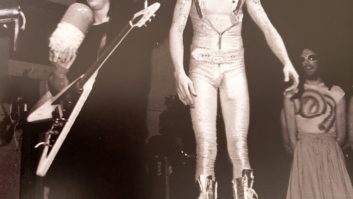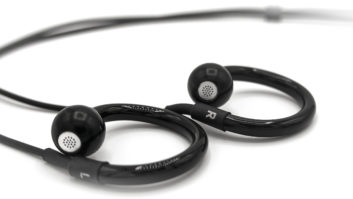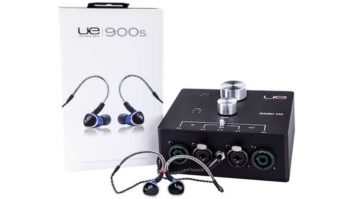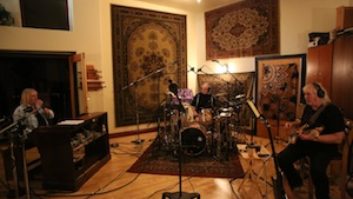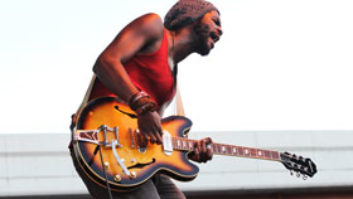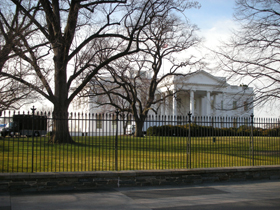
Music Mix Mobile’s black Voyager truck pulls up to the White House
Photo: Courtesy Music Mix Mobile
There are a lot of reasons not to envy President Obama’s job. But as he told a packed East Room on Presidents Day this year, “…and then there are nights when B.B. King and Mick Jagger come over to your house to play a concert.”
Before introducing King, the first artist to perform on a program called “Red White and Blues at the White House,” the president told his invited guests the story of Alan Lomax recording Muddy Waters in 1941 for the Library of Congress. In payment, Lomax sent the now-legendary artist two pressings and $20. Mr. Obama said this illustrates the blues’ “humble beginnings,” rooted in the history of black slavery and oppression.
Then B.B. King took the stage with Jeff Beck, Susan Tedeschi, Derek Trucks, Warren Haynes, Trombone Shorty, Shemekia Copeland, and a house band led by Booker T. Jones. Later performers included Jagger, Buddy Guy and Gary Clark Jr. And with Mr. and Mrs. Obama sitting front-row-center, the blues didn’t seem so “humble.”
On hand to capture the audio for the live stream on whitehouse.gov and for a later PBS broadcast was the Music Mix Mobile crew in their Voyager truck, which is fitted with Avid Pro Tools mixers/recorders and a 24-channel D-Command surface, Aphex 188 preamps and Genelec DSP monitoring. When Mix contacted Music Mix Mobile two days after the event, veteran engineer Jay Vicari was feverishly remixing the music, with an hour to go till he had to deliver files to Ken Erlich at AEG Productions—a process Vicari had started on Amtrak en route from D.C. back to New York City. Joel Singer, Music Mix Mobile’s technical director and co-owner, offers this inside look at what goes into a night of music at the White House:
“We roll in the day before setup for the show. First we have to pass the security checkpoint, which is a couple of blocks away from the White House. We open up the entire truck and give the Secret Service and their dogs the ability to go through it all: unload the belly carriers, open up cases, etc., so we can then roll into the secure part of Pennsylvania Avenue.
“We go through the Northeast Portico, and that process is a challenge in itself. All the ornate cement work leaves literally 108 inches for us to pass through, and our truck is 102 inches wide; that’s a very slim margin. The driveway has a 5-percent grade, too, so we have to level our trucks next, and then once we get power from their generators, we can start doing our cabling and put our preamps inside.
“Then it becomes a really surreal event, because you’re walking in and out of the White House like it’s the front door of your own home. There’s a guard there, of course, and everyone who goes through has already been prescreened. You get a special tag that has a sensor inside of it, so at any given time, they know exactly where you are.
“Once we get our pre’s inside, we get connected up to the P.A. that’s been installed by East Shore Sound, Bill Saltzer’s company. There’s limited room in there; you don’t bring big desks, and you don’t bring any gear you don’t need. That first day, we do all our checks to make sure our lines work—all the stuff that we’re doing from the room, and truck to truck with the video company, and once everything is set up we can go into rehearsals.
“We had everybody but B.B. King and Warren Haynes there on that Monday, so we were able to run through most of the numbers the day before.
“Everything at the White House starts ahead of time; if your call is 8 o’clock, you’ve got to be there by 7:30 so you can go through the security screening and get your tag for the day. We got in there about 10:30 on the day of show and got in a full dress rehearsal in the room.
“The East Room is a great room with a historical vibe. It is a little tight for an audience of 150 or 200. We keep a lot of stuff out on the roof that’s to the left of the East Room because you can’t fit everything. There are wood floors, hard surfaces, so there’s a little reverberance, but it’s a good-sounding space. They use the Blue Room next to it as kind of a staging area, and the Green Room as a meeting room, so they do give us a good section of the east side of the White House to do these shows.
“This program was only supposed to be 80 minutes, but it lasted two hours. Ron Reaves mixed the show [for the house]—the same guy who mixed the Grammys with us—and Mike Bove mixed monitors, and these are seasoned pros, but with something like nine guitarists onstage, a lot of it becomes a reinforcement gig and not a mixing gig.
“And then you have surprises like what happened with Trombone Shorty. He used a clip-on mic, so he could have freedom of movement, and he swung the horn one way, and that mic went flying a good 12 inches, so it was no longer pointing at his instrument; it was pointing at the band. But that’s why we have a talented remixer like Jay Vicari, who is digging it out of the mix and he’ll make it sound as good as it can sound.”
